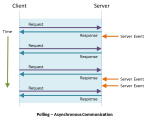For a list of protocols that support asynchronous communication, see 64-bit recording, Async, and IPv6 support.
Asynchronous communication is comprised of various request and response sequences. Such request and response sequences can be classified as one of three types of asynchronous communication: poll, push, and long-poll. When you develop a Vuser script, it is often useful to know the types of asynchronous communication that are implemented when the required business processes are performed.
Polling asynchronous communication
The browser sends HTTP requests to the server at regular intervals, for example, every 5 seconds. The server responds with updates. This enables the system to intermittently update the application interface inside the browser. If the server has no update, it informs the application that there is no update, based on the application protocol.
Long-polling asynchronous communication
The client generates an HTTP request to a known address on the server. Whenever the server has an update, it responds with an HTTP response. Immediately after receiving the server response, the client issues another request.
Push asynchronous communication
The client opens a connection with the server by sending a single HTTP request to a known address on the server. The server then sends a response that appears to never end, so that the client never closes the connection. Whenever necessary, the server sends a “sub message” update to the client over the open connection. The server may or may not terminate this connection. During the time the connection is open, if the server has no real update to send, it sends "ping" messages to the client to prevent the client from closing the connection for timeout reasons.
Note: Push-type conversations are supported for Web - HTTP/HTML protocol actions inside Web - HTTP/HTML and Web Services Vuser scripts.















